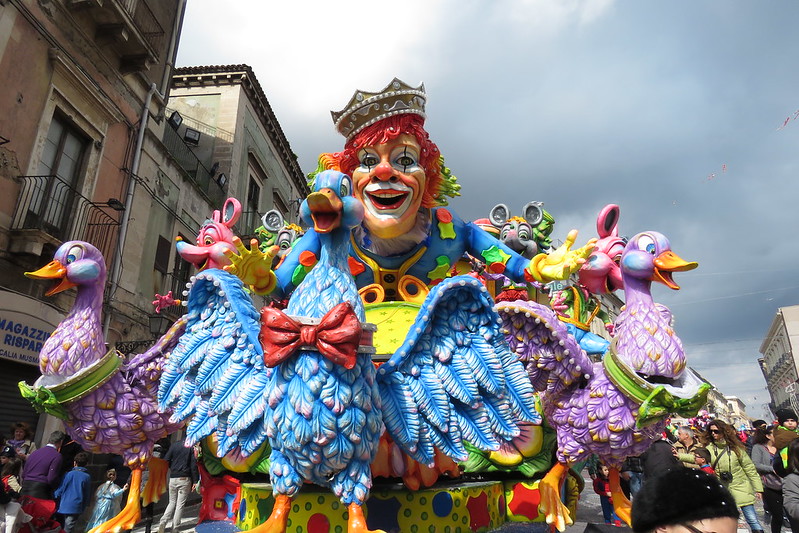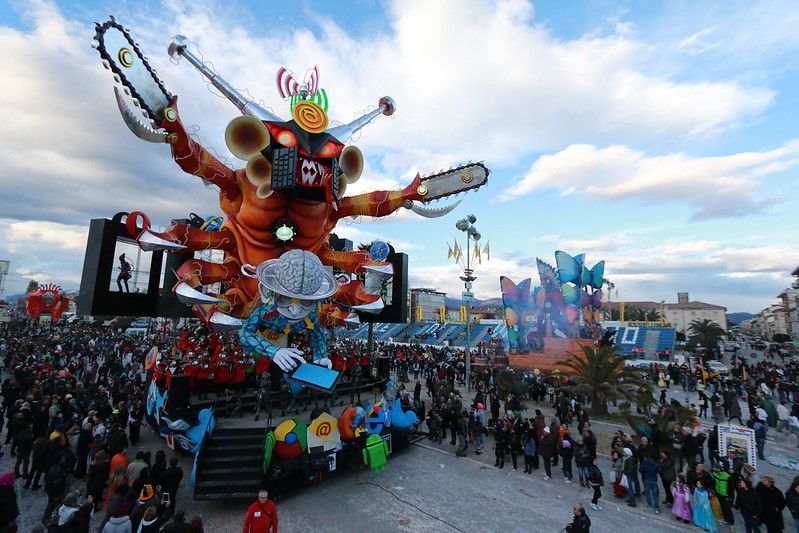Carnival of Viareggio (Carnevale de Viareggio)
A Spectacular Parade of Giant Papier-Mâché Masterpieces
2026/01/30 - 2026/02/21
Every February, the seaside town of Viareggio in Tuscany comes alive with a vibrant carnival. Along the Gulf Coast's Via Giuseppe Carducci, gigantic floats, about 20 meters high and 12 meters wide, parade through the streets. These floats feature a variety of enormous papier-mâché figures, satirizing current affairs or depicting monsters, crafted by artisans over an entire year. Around the floats, people in lavish costumes enliven the festival, while the Liberty-style promenade is filled with a colorful crowd. This carnival, one of the largest in Europe, attracts over 500,000 tourists annually and lasts for about a month. The Carnival of Viareggio is a true "moving art museum," blending Italian artistry, humor, and the joyful spirit of living.
Main Attractions
The Breathtaking Grand Parade
The highlight of Viareggio's Carnival is the grand parade held on four Sundays and one Tuesday during the festival period. At 2:30 PM, excitement builds along the coastal Via Giuseppe Carducci. Suddenly, the carnival's theme song rings out, and the first giant float slowly appears. These papier-mâché giants, standing 20 meters tall and weighing 40 tons, are truly moving works of art. With intricate mechanical designs, they blink their eyes, move their mouths, and wave their arms, seeming almost alive.
Each float sharply satirizes contemporary political and social issues, reflecting the year's current events. For example, you might see a certain country's leader whose nose grows with each lie, or a massive globe addressing environmental issues, all crafted with humor and keen critical spirit. Hundreds of dancers and musicians in colorful costumes surround the floats, engaging the audience and enlivening the parade. The 2-kilometer parade route is filled with colorful confetti, balloons, and the cheers of spectators, embodying the essence of a joyful Italian festival. The craftsmanship and creativity in every detail of the floats are astounding, with many spectators frantically trying to capture this spectacular sight with cameras and smartphones.
The Masked Revelry Spreading Through the Night City
As the sun sets, Viareggio transforms. In each district, known as Rioni, all-night costume parties begin. The scent of the sea mingles with the sweet aroma of freshly made frittelle (a carnival staple sweet), and the sound of clinking Prosecco glasses is constant. Impromptu dance parties spring up around the city, with the melodies of accordions and tambourines filling the night air.
The costumes of the participants are incredibly diverse. From traditional Commedia dell'Arte clowns and nobles to the latest anime characters, people parade through the streets in various disguises. Particularly eye-catching is the costume of "Burlamacco," the carnival's official mascot. Created in 1931, this character is known for its striking red and white harlequin-style outfit and can be seen all over the city. The act of wearing masks allows for interactions that transcend social status and age, transforming this usually quiet seaside town into a lively, vibrant alternate world for one night.
A Feast of Flavors Coloring the Carnival
The Carnival of Viareggio is a feast not just for the eyes, but also for the palate. As you walk through the streets, you're sure to be tempted by sweet aromas. The scent of frittelle, the carnival's signature sweet, wafts through the air. These small donut-like fried pastries are dusted with powdered sugar or filled with cream or chocolate. Street stalls sell chiacchiere (also known as cenci), thin strips of dough fried and then drizzled with honey or dusted with powdered sugar. Sold in paper cones, they offer a crispy texture that perfectly captures the carnival atmosphere.
But it's not just about sweets; local specialties are not to be missed. Restaurants offer special carnival menus. For instance, you can enjoy tordelli lucchesi, a meat-filled pasta with rich ragù sauce, or cacciucco, a fish-rich stew unique to Viareggio. Seafood dishes proudly carry on this port town's traditions. To accompany your meal, colorful cocktails or local Tuscan wines are recommended. Toasting with cheerful people around you will surely enhance your enjoyment of the carnival.
Cultural and Historical Background
The Carnival of Viareggio was born in 1873 from the rebellious spirit of local youth. At that time, wealthy young men, dissatisfied with high taxes, began parading flower-decorated floats through the streets as a form of protest. This small act of defiance eventually evolved into an annual event involving the entire town. The initially simple decorations on the floats grew larger and more intricate year by year. In 1925, a pivotal moment arrived with the introduction of papier-mâché (cartapesta) technique. This new material made it possible to create enormous floats up to 20 meters tall and weighing 40 tons. Today, over 200 artisans in 25 specialized workshops spend a year creating these artistic masterpieces.
For the people of Viareggio, this carnival is not just a tourist event. It is their very identity and a platform for expressing creativity and critical spirit. For example, in the 2019 carnival, a float satirizing Italian politician Matteo Salvini as a "villain" caused a significant stir. In 2020, a float themed around the novel coronavirus expressed people's anxieties and anger about the pandemic. In this way, the Carnival of Viareggio serves as a "moving political cartoon," sharply and humorously critiquing contemporary social issues and political situations. Not only local artists and craftsmen but also ordinary citizens participate in creating the floats. Through designing and building these floats, they voice their opinions to society. This tradition has been passed down through generations and continues to be a source of pride for the people of Viareggio.
Participant Voices
I'm an American exchange student studying art history in Florence. I decided to visit the Carnival of Viareggio to see the famous papier-mâché floats. What I experienced was beyond anything I could have imagined. The scale of the floats was mind-boggling - it was like walking through a living, breathing political cartoon. I was particularly struck by a float depicting climate change, with a giant globe that seemed to melt and reform as it moved down the promenade. The level of detail was astounding, from the expressions on the faces to the intricate mechanisms that brought everything to life. I spent hours sketching and taking photos, completely lost in the artistry. But it wasn't just the visuals that captivated me; it was the energy of the crowd, the way everyone came together to celebrate and critique society at the same time. I left with a newfound appreciation for the power of public art and a strong desire to return next year with my own mask and costume.
Fun Facts
- The Carnival of Viareggio uses over 1,000 tons of papier-mâché each year to create its massive floats.
- The official mascot, Burlamacco, is a combination of characters from the Commedia dell'Arte. Commedia dell'Arte is a form of improvised comedy that originated in Italy around the 16th century, featuring typical characters such as Harlequin (a witty servant), Balanzone (a scholarly old man), and Rugantino (a young lover). By combining these unique roles, Burlamacco has become a unique mascot that embodies both tradition and modernity.
- In 2001, the Cittadella del Carnevale (Carnival Citadel) was established. This complex consists of 16 enormous hangars, covering a total area of about 80,000 square meters. Here, artisans work year-round to create floats, and there's also a museum introducing the history of the carnival and workshops where you can learn papier-mâché techniques. It's open to the public, allowing carnival fans to observe the floats being made up close, making it a true mecca for carnival enthusiasts.
- The largest floats can accommodate up to 200 costumed figures and dancers. These participants wear costumes that match the theme of the float and perform acts and dances during the parade.
Festival Dates
The Carnival of Viareggio is typically held over several weekends from February to early March.
The event schedule is subject to change. Please check the official website for the most up-to-date information.
Information
| Name | Carnival of Viareggio (Carnevale de Viareggio) |
| Country | Italy |
| Area | Viareggio |
| Date | 2026/01/30 - 2026/02/21 |
| Link |
Upcoming Festivals
Whirling Dervishes Festival Turkey
A Mesmerizing Dance of Divine Love
2025/12/06Mevlana Celaleddin Rumi Commemoration Ceremony ( Şeb-i Arus ) Turkey
A Whirling Journey to Divine Love
2025/12/10Dia de la Virgen de Guadalupe Mexico
A Festival Weaving Faith, Fervor, and Mexican Identity
2025/12/11L'Escalade Switzerland
Geneva’s Grand Winter Festival of Courage, Chocolate, and Community
2025/12/12Umkhosi Wokweshwama South Africa
The Zulu First Fruits Festival—A Sacred Celebration of Land, Ancestors, and Renewal
2025/12/12Lucia Festival (St. Lucia's Day) Sweden
A Festival of Light Illuminating the Nordic Darkness
2025/12/15Las Posadas Mexico
The Luminous Quest for Sacred Shelter
2025/12/22Noche de Rabanos (Night of the Radishes) Mexico
A celebration blending art, farming heritage, and cultural traditions
2025/12/23Chant of the Sybil on Majorca Spain
A Medieval Prophecy Echoes Through Majorcan Christmas
2025/12/23‘Hatajo de Negritos’ and the ‘Hatajo de Pallitas’ Peru
A Christmas Festival of Rhythm, Faith, and Afro-Andean Heritage in Peru’s Ica Region

